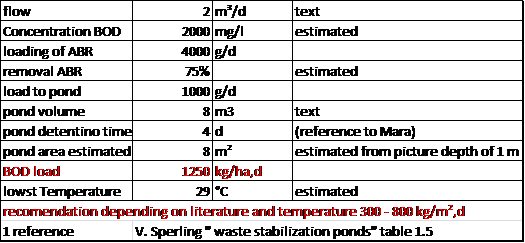- Forum
- categories
- Sanitation systems
- Treatment of wastewater, sludges, organic waste, excreta
- Decentralised wastewater treatment systems (anaerobic and aerobic), DEWATS
- More compact DEWATS technology?
More compact DEWATS technology?
51.8k views
Thanks. This is not an off topic though at all!
Roger Cox (NL): Circular Economy seems to be the first sound environmentally friendly moneymaking business-proposal. D.h. gesellsch., ökol. und wirtschaftl. Gewinn stehen nicht im Gegensatz zueinander, sondern ergänzen sich zu einem Prinzip, dass diesen Prinzipien, isoliert gesehen, bei weitem überlegen ist.
It is only my view as an outsider, not knowing the local customs and current business and behavior developments in India:
If you have to service 1,000 flats and calculating very conservative only 4 people per flat, you can calculate roughly 4,000 p.e. with maybe 800 mg/l COD (480 kg/d COD) you might have probably and theoretically a calorific value from biogas of 1,200 kWh/d (1 kWh = 3,6 MJ) = 440,000 kWh/a with an EURO value (with European prices 0.07 EURO/kWh)
= 30,000 EURO/a.
If calorific value converted to electric energy x 0.3 (for losses) 360 kWh/d = 131,000 kWh/a electrical power.
As this "imprisonment of rich people" (gated "community") is based on a strict business approach, the private investors would have probably a nice profit by converting permanent collected chemical energy in to heating or electrical energies. In my "little green frog" opinion, they would have a nice environmental side effect by making money out of GHG (CH4)... Making money instead of harm from Carbon Dioxide Emissions out of DEWATS.
I hope this investors had some internal profit calculation on that permanent (pipi & kaka) source of energy?
You may know the paper from your former BORDA-colleague Mr. Nils Warburg on "Calculation of Carbon Dioxide Equivalent Emissions of DEWATS in Indonesia".
All the Best
Detlef
Please log in or register to see it.
"simple" Sanitation-Solutions by gravity
Low-Tech Solutions with High-Tech Effects
"Inspired by Circular Economy and Cooperation"
www.flickr.com/photos/aqua-verde/
This message has an attachment file.
Please log in or register to see it.
Please Log in to join the conversation.
You need to login to reply- jankn
-
 Less
Less- Posts: 35
- Karma: 8
- Likes received: 21
Thank you for the questions. We do have quite some DEWATS here that us biogas (e.g. one in a slum-resettlement colony directly opposite our current office where we currently do some research on performance during hydraulic and organic overloading), however, I cannot speak for our partner organizations that implemented the DEWATS I talked about earlier.
At least for the housing complex in Bangalore, I know that it was a first demonstration project to VBHC, a local builder, that now wants to adopt DEWATS technology for all their future apartment buildings, afaik. Possibly, they will aim for a biogas option if there is reuse potential. Just out of interest, would you (or anyone) see a potential for biogas use in a middle-class housing complex with 1000 flats? This might be off topic though.
Anyway, I will meet one of the engineers that was involved in the VBHC project next week and I will drop the questions why they chose vortex over other techniques. But my first guess would be to "hide" the whole system and not have it cascading down in front of a kitchen window of good paying tenants or so. Still, once flushed most people do not really want to deal with their waste anymore in any way. The cylinders are solid concrete and you have no idea of what is going on inside if it wasn't for a mirror at the ceiling of the filter/votex house. The transparent systems used by CSR are only for demonstration, I suppose.
Ben, sorry to hear, the project was abandoned.
Doctoral Researcher on environmental performance assessment and modeling of on-site wastewater treatment systems
Trinity College Dublin & University of Limerick
Email: jan.knappe(at)tcd.ie, Twitter: @JanKnappe
Please Log in to join the conversation.
You need to login to reply- ben
-

- Water and sanitation engineer
Less- Posts: 107
- Karma: 11
- Likes received: 57
Just to give you updates as promissed. Bad news as the farmer didn't manage to start a sludge removal business because he didn't want to take a credit of 20 000 $ for the vaccuum truck. As many project, the technology of treatment was probably good (or probably not) but we'll never know because we made big mistakes on other aspects, in this case the technology of sludge pumping.
I shared the bad experience I had with the emptying system at the time on ecosanres, I attached the discussion and some photos of our cheap (too cheap !) pumping system.
Hope someone will learn from these mistakes so they won't have been done in vain. Conclusion is :
Pumping sludge with a centrifugal pump is almost impossible, vacuum is the technology the most adapted for the task.
Wish you all a good day.
Ben
This message has attachments files.
Please log in or register to see it.
Please Log in to join the conversation.
You need to login to replyThanks for the overview on some DEWATS in India.
It is a pity, non of the explained anaerobic DEWATS is using the produced bio-gas. Do you visited examples of DEWATS with bio-gas use too?
The aeration of effluent via cyclone (vortex by Auroville Center) is one of many methods of possible aeration systems after an O2 consuming anaerobic step. For the following aerobic biological treatment via bio-film in sand-filter any pre-aeration (gas exchange) of effluent is recommended and very helpful. What are the real advantages of the described cyclone-aeration (vortex) system in comparison to an e.g. cascade system?
Any science based technical information I prefer. Advertisements are not enough.
The recommended transparent tube for a cyclone-aeration (vortex) might be OK for a nice but very temporary esthetic view and for advertisements too. As the anaerobic system is not eliminating nutrients the transparent tube will accumulate very fast algae on the inner wall (light + temperature + water + nutrients = algae).
I am not sure you can answer on that as you been "only" a DEWATS-observer. May you forward my question to the relevant persons in Auroville, so they could answer here in the forum?
All the Best
Detlef
"simple" Sanitation-Solutions by gravity
Low-Tech Solutions with High-Tech Effects
"Inspired by Circular Economy and Cooperation"
www.flickr.com/photos/aqua-verde/
Please Log in to join the conversation.
You need to login to reply- jankn
-
 Less
Less- Posts: 35
- Karma: 8
- Likes received: 21
I had the opportunity to see some of the DEWATS implemented by ENPHO in the Kathmandu Valley this summer. In general, Nepali DEWATS mainly use vertical filters after the ABR (compared to horizontal filters here in India). This is one means to minimize the needed surface area and account for the ground slopes in hilly regions.
However, these vertical filters rely on a dosing system. This somehow contradicts the pure DEWATS philosophy to avoid mechanical parts, but as mentioned earlier, there is always a trade off between several factors during planning. Though, we found most of the siphon-type dosing systems (including Sushma Koirala Hospital and Dhulikhel Hospital, mentioned by Freya) not functioning which led to continuous load of the vertical filters and ultimately ponding on the surface. This emphasizes the need for regular and trained O&M even with low-maintenance technologies. Though, COD effluent samples were ca. 30 mg/l for Sushma and 100 mg/l for Dhulikhel at the end of the monsoon season.
In India, there are some DEWATS implemented using vortex systems to further treat the ABR effluent. Most prominently the system by CSR Auroville (more info here) ; or a recent project at a housing complex in Bangalore where a vortex systems is used in combination with a sand and carbon filter plus chlorine dosing (reuse of effluent for toilet flushing). I attached a recent study published by CDD Society below.
As Detlef also mentioned, BORDA Afghanistan implemented a two storey ABR that saves some space. You can find more information about this design here at Susana .
/Jan
Please log in or register to see it.
Doctoral Researcher on environmental performance assessment and modeling of on-site wastewater treatment systems
Trinity College Dublin & University of Limerick
Email: jan.knappe(at)tcd.ie, Twitter: @JanKnappe
This message has an attachment file.
Please log in or register to see it.
Please Log in to join the conversation.
You need to login to replyfor your courage and for sharing your "Trails & Errors" with us, so many can learn from you on very practical terms. Your shown example is very typical as engineering plans and made projects moving on.
Thanks again.
Detlef
"simple" Sanitation-Solutions by gravity
Low-Tech Solutions with High-Tech Effects
"Inspired by Circular Economy and Cooperation"
www.flickr.com/photos/aqua-verde/
Please Log in to join the conversation.
You need to login to reply- ben
-

- Water and sanitation engineer
Less- Posts: 107
- Karma: 11
- Likes received: 57
Thanks for your interest and critics, this is truly appreciated.
I believe I need to give you some background of the project.
Basically I was in Cambodia, we had 20 000 dollars and needed to build up some sludge management pilot project. Funder wanted to try need ways to deal with the tons of sludge thrown in the rivers every day in Phnom Penh.
We decided, rather than employing the sludge removers and building them a plant (big land problem in Phnom penh, almost impossible to find some public space necessary), to propose to a farmer to build a plant on his field and to help him devellop the pit emptying business and reuse the compost on his mango and papayas fields. We managed to build this plant for 12 000 dollars, no electronic nor chimical products etc ... We never pretend we were bringing drinkable water on the oulet but the four phases anaerobic / aerobic / drying / Composting were the best we could do in a limited space with the given budget. No energy - No electronic - No chimicals - Reuse of the Sludge in the nearby field. This was the idea.
One big economy we did was making all the walls in bricks with a cement coating (with Sika Latex to make it waterproof) rather than full concrete walls.
We though we would get some extra funding for all the chemical tests but sadly we didn't get them, the farmer has been hard to convert into the pit emptying business as well so the project hasn't been a complete success.
Technically, and to answer partly the points you raised Christoph :
I agree that the aerobic is far to small, something would be needed to aerate it. The settling pond isn't working properly either, this is sure. Many improvement could be really done but we wanted to build something scalable with small budget, no need of external energy or particular knowledge to operate it. Many times in sanitation I believe if we stick too much with the WHO guidance treatment plants need to be technological, complecated and not sustainable. Best is the enemy of good and if we manage to treat sludge before it reaches rivers, even a little bit, with very simple technology then this might be a progress.
It was supposed to be a pilot test so I could today give you updates on the process for what works and what doesn't, I'm sorry I can't provide you all that now. I've contacted the team there to get some updates, so I'll be able to tell you more in a few days.
I attached some photos and the concept note we did at the time.
Ben
This message has attachments files.
Please log in or register to see it.
Please Log in to join the conversation.
You need to login to replyI would like to bring up some skeptics about this design which seems critical to me – for sure I would be interested if the results in practice prove me wrong (and I would be happy about that).
a) I imagine you have a lot of sand in the sludge – how is maintenance done of the first settling chamber? I think it will fill up very quickly, sand will pass on to the second chamber (first of "ABR") where is no removal possibility. And a settling chamber of theoretically 1 day, in reality has two loadings of 1 m³ pulse loadings per day. The loading of 1 m³ in (estimated) 15 min = 50% of the total volume will stir up the sludge, so the settling is not really 1 day.
b) I never saw an anaerobic tank with a pressure head of 1 m as in your design. This means that scum will be trapped in the chamber, compressed. How do you allow gas to go out? I would fear that this thing explodes one day as the gas trapped in the scum has no way out.
c) The “pond” is totally overloaded, no chance to be aerobic. My rough calc below indicates an overload of 50 – 400 %. You have to consider that an area of 8 m² can not be calculated as a lagoon. The side effects are huge. Much more still with a pulse loading of 1 m³ twice a day = 12% of lagoon content / puls.
Please don´t take these critics bad, I thought I have to bring up some concerns as nobody asked and there might be people who are thinking it is good to copy the design. I apologize if it sounds harsh and would be happy to hear something about the results in practice.
Yours
Christoph
Please log in or register to see it.
Attachments:
-
 designben.png
(Filesize: 17KB)
designben.png
(Filesize: 17KB)
Please Log in to join the conversation.
You need to login to replyMike - eco1solutins.com This email address is being protected from spambots. You need JavaScript enabled to view it.
cheers : )
Please Log in to join the conversation.
You need to login to replyI am not involved in possible Nepal project, but I think your space saving solution is interesting, it reminded me of a stabled ABR by BORDA in Afghanistan, having the same space constrains at a moshe.
Maybe it is a good idea to share the mentioned details with susane-office to put it on the general susana-library.
All the Best
Detlef
"simple" Sanitation-Solutions by gravity
Low-Tech Solutions with High-Tech Effects
"Inspired by Circular Economy and Cooperation"
www.flickr.com/photos/aqua-verde/
Please Log in to join the conversation.
You need to login to reply- ben
-

- Water and sanitation engineer
Less- Posts: 107
- Karma: 11
- Likes received: 57
With GRET we worked in Cambodia on a kind of compacted DEWATS, I invite you to look at the concept note attached. The idea was to place an aerobic pond on top of the anaerobic one, followed by a drying bed. Economy of space, of material, gravity flow, etc ...
We constructed the structure but faced some trouble with the pit sludge removal business model. Budget for testing quality of effluent haven't been properly carried on either, which was a shame. If someone is interested I can send plans, photos and ask some feedback on how is the project going in Cambodia.
Wish you all a good day,
Ben
This message has an attachment file.
Please log in or register to see it.
Please Log in to join the conversation.
You need to login to replyA polyurethane trickling filter, or the advanced version of it e.g. a down-flow hanging sponge system might also be worth looking into.
Polyurethane filter foams can also be impregnated with silver-nitrate (a technology known from drinking water disinfection), which might be interesting for a final polishing step in the case of a hospital.
Please Log in to join the conversation.
You need to login to reply- Forum
- categories
- Sanitation systems
- Treatment of wastewater, sludges, organic waste, excreta
- Decentralised wastewater treatment systems (anaerobic and aerobic), DEWATS
- More compact DEWATS technology?








